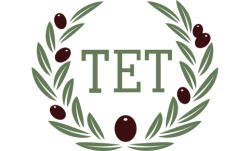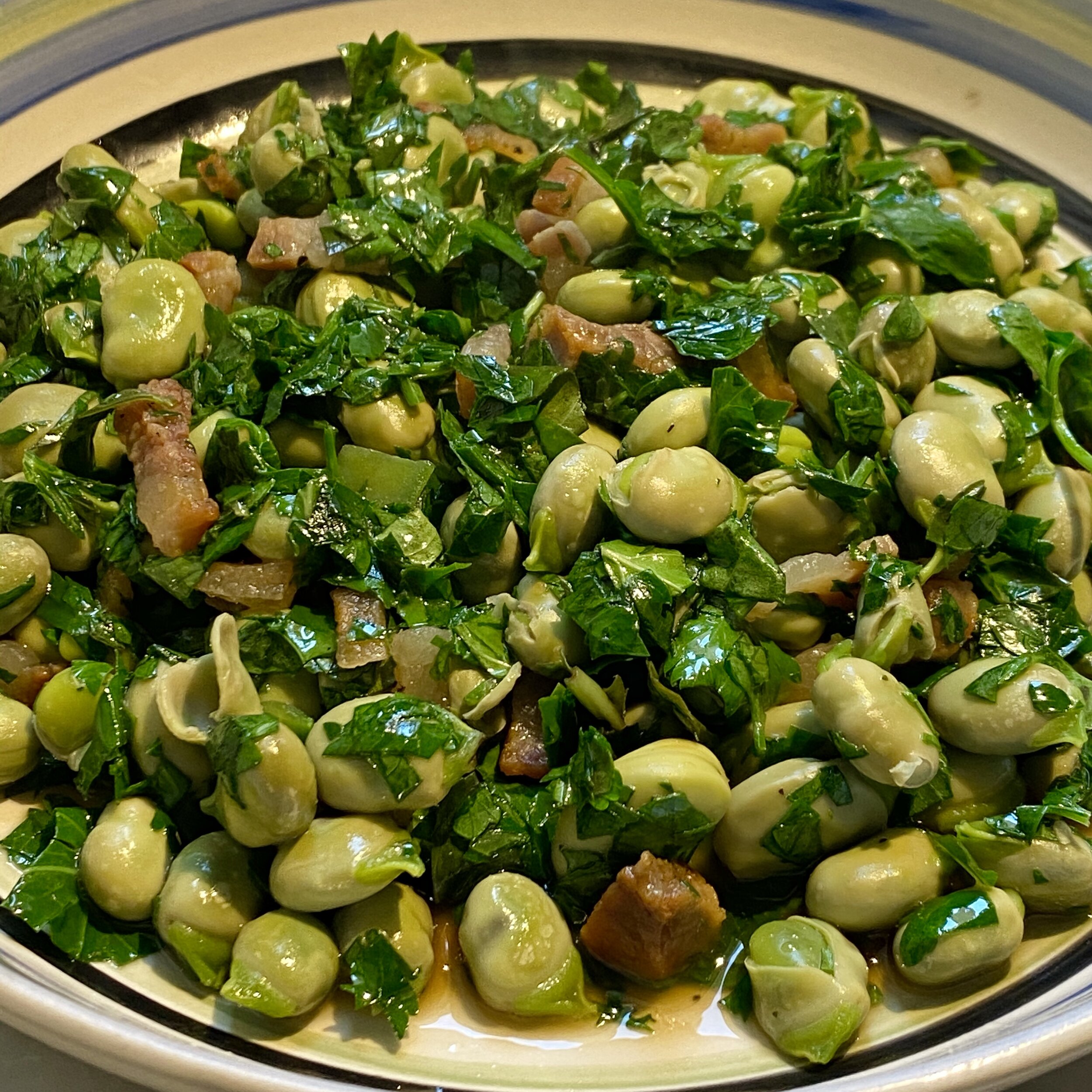Fresh fava beans enjoy an ample market window throughout spring. When they first appear in central Italy where I live, they are generally eaten in their simplest form - raw with a side of fresh or medium aged pecorino cheese. Pods are piled onto the table, and eaters rip them open, plucking the beans one-by-one from their plush green casings. Each bean is paired with a morsel of cheese and the rest is predictable.
This is not any tastier than you imagine it being. Raw beans and cheese. I’ve always felt that the cheese was somehow a chaser, an encouragement or compensation for having chewed up a raw fava bean and swallowed it. But don’t let me condition you. While the attraction escapes me personally, it’s a long-standing tradition.
Fava beans packed inside soft, thick pods.
I am hardly a Pythagorean, though…
Pythagoras (c. 570 - c 495 BCE) was not only militantly vegetarian, he also eschewed beans. He believed that they were the leguminous brethren and sistren of humans. Following empirical observations, he concluded that when a bean was embedded in the womb of mother earth (ok, under the soil), it grew in a way that resembled a fetus and, thus, humans and beans were cosmically linked, body and soul.
Pythagoras - A human bean (Pennington, 2010)
As a philosopher, the human/bean dichotomy may have have stirred apprehension about metempsychosis, the life-death-rebirth cycle, musings which invariably brought Hades, god of the underworld, into the discussion. For Roman statesman Cicero, that was a crock. Ever critical of the Greeks, he sneered that Pythagorean bean refusal had more to do with flatulence than philosophy.
A more brass tacks explanation is that Pythagoras was phobically aware of the toxicity of legumes, the most dramatic perhaps being the fatal reaction that many Mediterranean peoples had to fava beans due to a genetic mutation. For some, the mere exposure to fava bean pollen suffices to trigger “favism” - hemolytic anemia or the rupturing of red blood cells.
Interestingly, carriers of the gene which made them susceptible to favism tended to inhabit areas where malaria was endemic - and the disease rendered them immune to malarial ravages. In the final analysis, immunity to malaria was not such a bad trade off. More about this in The Eternal Table - A Cultural History of Food in Rome.
There are many hypotheses surrounding Pythagoras’s demise, but here’s the one that is apropos of our story: while fleeing from a band of detractors, he ran into a metaphorical brick wall: a bean field. Even to save his own life, he refused to trample on it. His pursuers then pounced with their steely blades, spilling Pythagoras’s blood onto the field of his kin.
(End rabbit hole).
Pythagorus favored education for both women and men.
Maestro Martino and the fava bean revival
In the 1984 issue of the Gastronomic Guide of Italy, a respected publication of the Touring Club Italiano, authors noted that fava beans were falling into rapid obscurity on the Italian table. They attributed the disappearance to the care and time required to prepare them, observing that modern families preferred foods that could be served up quickly. Finding fava beans in restaurants, they said, was “pure utopia” and, should you come across them in an out-of-the-way trattoria, you had best get them while the getting was good.
My threshold for laborious food preparation probably well exceeds the average, albeit in a skewed, OCD sort of way, but I am going to propose we travel back to the Middle Ages to chef Maestro Martino to resuscitate three fava bean dishes that are a joy to prepare, delicious, and may save the fava from undeserved ignominy.
Introducing the maestro:
Many valiant culinary historians have gone to heroic lengths to piece together the nebulous details of Maestro Martino’s life, but alas, little is is known with certainty. In a nutshell, it is most plausible to say that he was a Swiss Lombard chef, who at the height of his industry operated in Rome prior to which he had spent a significant sojourn in Naples.
Warning: culinary scholars may want to brace themselves while I oversimplify his output -
Libro de arte coquinaria - Maestro Martino
The maestro wrote his magnum opus Libro de arte coquinaria - The Art of Cooking - in 1465; it reflects his experience in the south for which it is assumed that it was written there. For example, it contains a recipe for mollignani - eggplant - which was virtually unknown in Lombardy, but common in the region of Campania having been introduced during Spanish dominion.
The Art of Cooking is considered a pivotal moment in culinary history - it reflects post-classical era cookery and yet stands on the cusp of the Early Modern Age, thus straddling the Middle Ages and the Renaissance.
Ok, exhale.
Martino was a chef to the aristocracy, but the three fava bean recipes here are homey and hearty. That is not to say they are stomach-fillers lacking in refinement. In equal measure, they would lend elegance to a weeknight meal or balance a fancy dinner - impress your family, comfort your guests. All good.
HOW TO MAKE FAVA BEANS EVERY WAY
This heading was followed by three recipes for fava beans. The first is with dried fava beans and the second two are with fresh ones.
Fava bean purée
INGREDIENTS:
200g dried split fava beans - soaked overnight
1 small onion finely chopped
130g chopped sweet apples
70g dried figs soaked in warm water then chopped
2 tbsp chopped parsley
2 tbsp torn fresh sage leaves
1 tsp and 1/2 tsp sweet spice mix
1 tsp salt
4tbsp olive oil
Drain the fava beans and rinse. Put them in a small saucepan with salt, pour water on to cover, and bring to a boil. When they get foamy turn the heat down and cover.
Cook about 15 min. or until the larger bits have started to disintegrate. Puree with an immersion blender. Cover and set aside.
Prepare the topping: Heat the oil in a small skillet. Add the onion and fry on high until it starts to brown, then lower to heat and cook until it starts to soften.
Add the rest of the ingredients and sauté at medium high until moderately soft but not mushy. Salt to taste.
In the meantime, the fava purée will have stiffened and should be solid enough to hold up a spoon
Heat the purée to warm it and place a portion on each person’s plate or prepare a platter.Top the purée with the apple mixture, a drizzle of olive oil, and a sprinkling of the spices and serve warm.
Variation with fresh fava beans
The ingredients are the same as above except use half the quantity of sage (if you want) and, instead of dried fava beans, boil 300g fresh, green fava beans in salted water until they just soften.
Prepare the same accompanying mix as above:
When the complementary ingredients have cooked and are well combined, add the cooked fava beans and toss. Serve warm or room temperature.
Fresh fava beans and herbs
INGREDIENTS:
200g fresh shelled fava beans
500ml meat broth (or water)
75g diced pancetta or guanciale
1tbsp olive oil
3 tbsp chopped parsley
2 tbsp chopped mint
salt
INSTRUCTIONS:
Boil the beans in broth until just cooked.
Heat the olive oil and fry the pancetta until crisp.
Toss the beans in the pancetta on high for one minute.
Add the chopped herbs and sauté for another minute tossing. Salt to taste.
Serve warm or at room temperature.
I leave you with that in the hope that I have done my part to keep fava beans part of the culinary vocabulary of Italian cuisine.



















